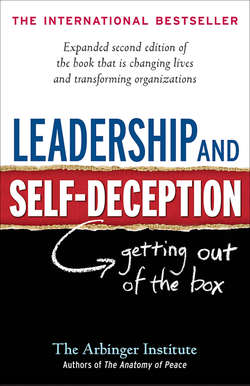Leadership and Self-Deception. Getting out of the Box

Реклама. ООО «ЛитРес», ИНН: 7719571260.
Оглавление
The Arbinger Institute. Leadership and Self-Deception. Getting out of the Box
Preface
PART I. Self-Deception and the “Box”
1 Bud
2 A Problem
3 Self-Deception
4 The Problem beneath Other Problems
5 Beneath Effective Leadership
6 The Deep Choice That Determines Influence
7 People or Objects
8 Doubt
PART II. How We Get IN the Box
9 Kate
10 Questions
11 Self-Betrayal
12 Characteristics of Self-Betrayal
13 Life in the Box
14 Collusion
15 Box Focus
16 Box Problems
PART III. How We Get OUT of the Box
17 Lou
18 Leadership in the Box
19 Toward Being Out of the Box
20 Dead Ends
21 The Way Out
22 Leadership Out of the Box
23 Birth of a Leader
24 Another Chance
How to Use Leadership and Self-Deception
Share Your Story
AN EXCERPT FROM THE ANATOMY OF PEACE
About THE ARBINGER INSTITUTE
Отрывок из книги
For too long, the issue of self-deception has been the realm of deep-thinking philosophers, academics, and scholars working on the central questions of the human sciences. The public remains generally unaware of the issue. That would be fine except that self-deception is so pervasive that it touches every aspect of life. “Touches” is perhaps too gentle a word to describe its influence. Self-deception actually determines one’s experience in every aspect of life. The extent to which it does that – and in particular the extent to which it determines the nature of one’s influence on, and experience of, others – is the subject of this book.
To give you an idea of what’s at stake, consider the following analogy. An infant is learning how to crawl. She begins by pushing herself backward around the house. Backing herself around, she gets lodged beneath the furniture. There she thrashes about, crying and banging her little head against the sides and undersides of the pieces. She is stuck and hates it. So she does the only thing she can think of to get herself out – she pushes even harder, which only worsens her problem. She’s more stuck than ever.
.....
We have written this book to educate people about a solution to this most central of problems. Our experience in teaching about self-deception and its solution is that people find this knowledge liberating. It sharpens vision, reduces feelings of conflict, enlivens the desire for teamwork, redoubles accountability, magnifies the capacity to achieve results, and deepens satisfaction and happiness. This is true whether we are sharing these ideas with corporate executives in New York, governmental leaders in Beijing, community activists on the West Bank, or parenting groups in Brazil. Members of every culture participate to one degree or another in their own individual and cultural self-deceptions. The discovery of a way out of those self-deceptions is the discovery of hope and the birth of new possibilities and lasting solutions.
This book was first published in 2000, with the paperback appearing in 2002. In this new edition, published in 2010, the text has been updated, and we have added a section at the end that describes the various uses people have made of the book and its ideas over the last decade. Initially, some readers are surprised to find that the book unfolds as a story. Although fictional, the characters’ experiences are drawn from our own and our clients’ actual experiences, so the story rings true, and most readers tell us that they see themselves in it. Because of this, the book delivers not just conceptual but also practical understanding of the problem of self-deception and its solution. The resulting impact has made Leadership and Self-Deception an international bestseller that is now available in over 20 languages. Our most recent bestseller, The Anatomy of Peace, published in hardcover in 2006 and in paperback in 2008, builds on both the story and the ideas developed in Leadership and Self-Deception. Individually and together, these books help readers to see their work lives and home situations in entirely new ways, and to discover practical and powerful solutions to problems they were sure were someone else’s.
.....